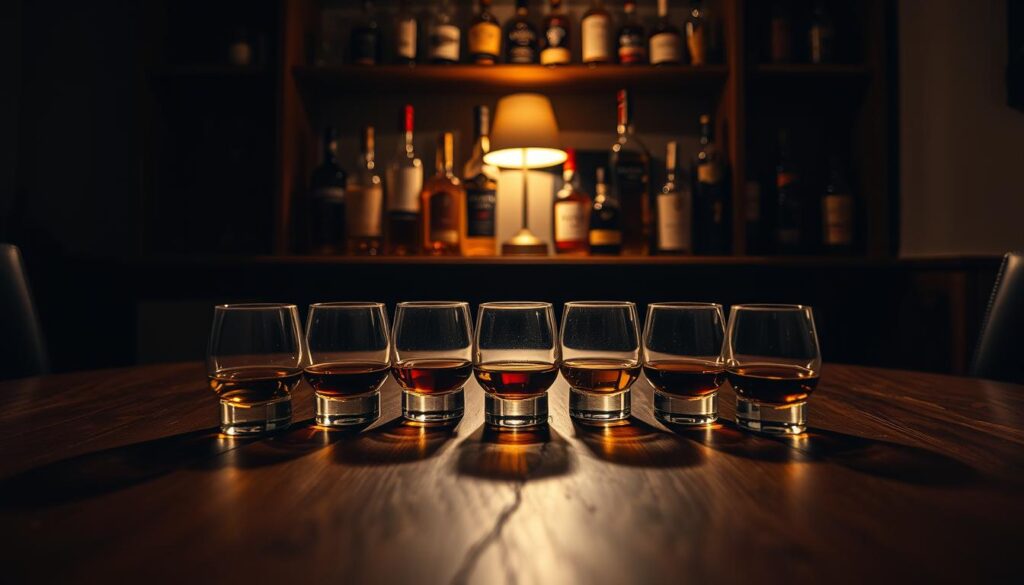Welcome to this friendly guide on how to taste whiskey. It’s your key to loving this bold spirit even more. Every glass tells a story, one that unfolds with each sip.
You’ll discover how to find hidden notes and subtle aromas. Imagine smoky hints in a Glenfiddich single malt or sweet vanilla in a Maker’s Mark. This guide helps you enjoy every drop with confidence.
Understanding the Basics of Whiskey
Whiskey has many styles, thanks to different grains and aging methods. Bourbon uses corn, Scotch relies on malted barley, and Irish whiskey is triple distilled. Each style builds a rich tradition for whiskey lovers to explore.
Learning about whiskey reveals how each element affects its taste. This knowledge helps you enjoy whiskey even more.
Grains and aging barrels shape a whiskey’s flavor. For example, Jameson from Ireland is smooth, while Maker’s Mark from the U.S. is sweet. Trying different whiskeys lets you discover new aromas and textures.

Preparing for a Whiskey Tasting
Getting ready for a whiskey tasting is all about planning. Use a whisky glass like a Glencairn or tulip-shaped snifter to catch the aroma. This helps bring out the whiskey’s hidden flavors.
Also, keep the whiskey at a slightly cooler temperature. This makes the flavors more delicate and prevents strong alcohol smells. It’s a great way to enjoy the whiskey’s unique taste.
Try mixing single malts, blends, or craft whiskeys for each tasting. This mix of flavors adds excitement and depth. For more knowledge, check out the premium Scotch whisky essentials. It offers insights into how it’s made, regional differences, and more.
Sampling different types of whiskey helps you appreciate the subtle differences. It shows you the best way to taste whiskey from various perspectives.
The Visual Aspect of Tasting
Looking at the liquid is key in any whiskey tasting guide. The color, from pale gold to deep amber, tells us about the barrel and aging time. Brands like Glenfiddich or Jack Daniel’s show off their unique colors.
Clarity tells us about how the whiskey was filtered. A bit of haze doesn’t always mean it’s not good. It might just show it was processed lightly. This first look prepares us for the smells and tastes that follow.
A gentle swirl makes the whiskey’s “legs” appear in the glass. Slow-moving streaks suggest a richer mouthfeel. Quick lines might mean it’s lighter. This visual hint sharpens our senses before we take a sip.
Engaging Your Sense of Smell
Swirling the glass frees hidden hints that spark curiosity and enrich each sip. Gently allow scents of oak, caramel, and fruit to emerge. Certain expressions, such as Macallan or Maker’s Mark, may greet your nose with vanilla or warm spice.
Inhaling slowly sharpens your awareness, while a second sniff might reveal a subtle layer of citrus or honeyed sweetness.
Nosing becomes an art when your breathing technique is steady and relaxed. Holding the rim a short distance from your nostrils prevents overpowering fumes. This encourages you to savor nuanced aromas.
Learning how to develop a whiskey palate involves tuning in to each whiff. This process builds confidence over time. It guides you to recognize complex characteristics hidden beneath the surface.
A structured approach to smelling promotes deeper insights. It opens doors to new taste discoveries. This enhances your appreciation for every pour.
The Art of the First Sip
That first moment the whiskey touches your lips can reveal surprising depth. Notice how it feels on your tongue. Does it feel light and smooth or bold and firm?
A brand like Jack Daniel’s might give you subtle caramel notes. On the other hand, a Kentucky bourbon might bring toasted oak flavors. Each one adds to your journey of exploring whiskey.
Pay attention to these first impressions. They help you spot unique traits in every whiskey. Some might taste delicate spice, while others have a smoky twist that stays with you.

Exploring Flavor Profiles
Exploring flavors in whiskey can be exciting. Start with lighter whiskeys to catch hints of fruit or vanilla. Then, try bolder ones like smoky scotch or rich bourbon for a deeper taste.
Every region’s whiskey has its own unique taste. Irish whiskeys might have floral notes, while American ones often have strong oak flavors. Knowing how to taste whiskey helps you notice these differences.
Pairing whiskey with food can also reveal new tastes. A cheese can bring out sweet caramel notes, while dark chocolate enhances spice. Trying different foods with your whiskey can uncover new flavors.
Evaluating the Aftertaste
The end of a sip can show layers you might not see at first. A smooth finish means the whiskey is mature and well-balanced. A short finish feels quick but can still be interesting.
Watching how flavors stay or disappear helps improve your whiskey notes. Some whiskies leave hints of oak or spice that slowly fade. Others leave fruit or chocolate notes that disappear quickly. Noticing this final stage helps you trust your taste.
Each finish tells us about the quality of the cask and the whiskey’s age. It’s a moment to enjoy, showing what makes one whiskey different from another.
Developing Your Personal Palate
Training your senses starts with curiosity. Start by trying whiskies from well-known distilleries like Jack Daniel’s or The Glenlivet. Notice how age, region, and barrel type create different tastes.
Use a notebook to record your thoughts. Write down the flavors that catch your attention. See how each sip changes over time. This helps you notice more with each try.
Trying different whiskies broadens your view. With practice, you’ll get better at noticing small smells or tastes. Your confidence in tasting will grow. Each sip becomes a chance to learn and enjoy more.
Tips for Hosting a Whiskey Tasting Event
Planning a whiskey tasting at home? These simple tips will help you create a memorable and engaging experience for your guests.
- Use warm lighting to help guests focus on the color of each whiskey. Include local favorites like Jack Daniel’s or Jim Beam, and add single malts like Glenlivet for variety.
- Encourage questions to spark curiosity and discovery. A relaxed, open atmosphere helps everyone feel comfortable learning how to taste whiskey.
- Provide aroma kits with scents like vanilla or oak to inspire conversation about cask influence. Hand out simple note cards for guests to jot down tasting notes.
- Make it personal. Let each guest explore their own tasting style. Laughter and open discussion make every sip more enjoyable and memorable.
- Surprise guests with rare or limited-release bottles. Compare regional varieties, such as an Irish Jameson and a spicy American rye. Offer snacks to cleanse the palate.
- Create a thoughtful setup that brings people together and deepens appreciation for every unique pour.
Savor the Journey: Your Whiskey Adventure Awaits
Whiskey tasting goes beyond just taking a sip — it’s an experience that honors tradition, expert craftsmanship, and your own journey of discovery. From the moment you observe its color to the final whisper of aftertaste. Each step deepens your connection to this timeless drink.
Your palate is your passport to a world of flavor. Whether you love Islay’s smoky Scotch or Kentucky’s rich bourbon, there’s something to explore. So take your time. Swirl, sniff, sip — and let the whiskey speak.Ready to keep exploring the bold world of whiskey? Dive deeper into tasting notes, distillery stories, and expert tips at Scotland Whisky. Whether you’re a curious beginner or a seasoned connoisseur, there’s always more to discover. Stick around, pour another dram, and explore the spirit of Scotland — one blog post at a time.